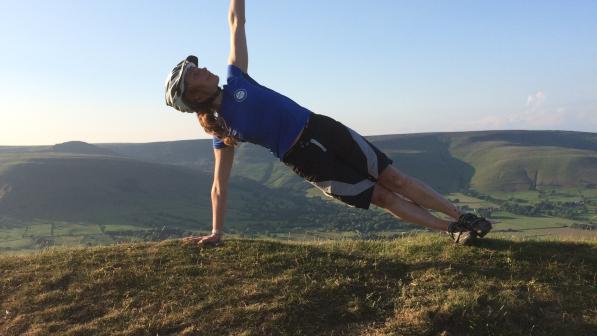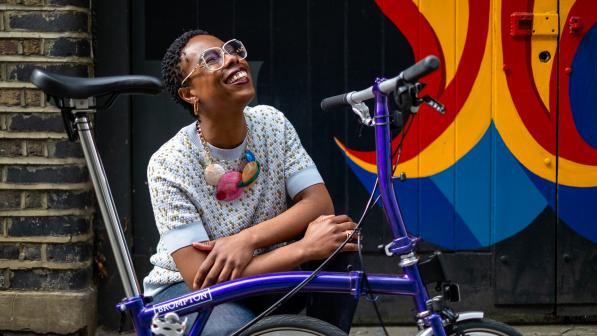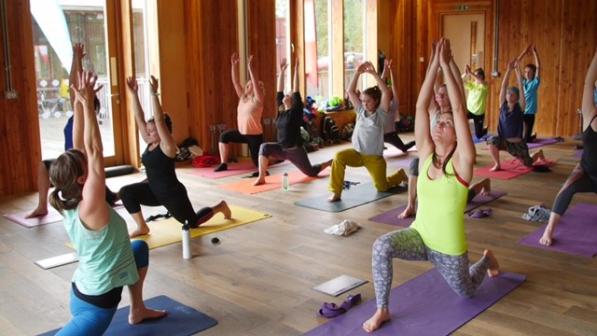Five indoor exercises for cyclists

Safety first
It’s important to ensure you have no health or lifestyle issues that might need to be addressed in more detail by a GP before undertaking a new or different programme of exercise.
You can complete a Physical Activity Readiness Questionnaire (PAR-Q) yourself online and if you answer yes to any of the questions, please consult your doctor before trying any new exercise regime.
Why bother doing strength training?
Some people cycle and don’t do any other kind of physical activity. That could be fine for you. However, if you’ve not been able to get out for your regular ride recently, it’s possible that you’ll have lost some of the strength you had previously. Doing some simple bodyweight (no equipment needed) exercises can keep your strength and fitness levels up, ready for the spring weather.
Another reason to incorporate strength and conditioning into your routine is to improve your cycling and reduce injury. Cycling asks your body to do a repetitive action, in the same position, potentially for long periods of time. Ensuring that you have core strength to maintain good posture will improve your performance.
If you've never done any strength training before, the exercises below are a great way to start. There are lots of misconceptions about strength training. People worry they will build up big bulky muscles and become less flexible, or that big heavy weights are required. Some people even think that strength training is not something beneficial for women. The truth is that strength training is a great way to supplement your riding, keep yourself fit and improve your performance.
Even if you’re not doing any strength training, cycling is a great form of exercise. Health benefits include fat loss, improvements in heart and lung function, and overall fitness levels. There are also benefits to our mental health and wellbeing which should not be underestimated. If strength training isn’t for you, don’t worry, just by cycling you’re already doing something fantastic for your body and mind.
Which muscles are involved in cycling?
Cycling is a fantastic non-weight bearing exercise that works a huge range of muscles in your body, not just your legs. Before thinking about what specific strength exercises you want to do, it’s important to understand the different muscles being worked when you’re cycling.
For the purposes of this article, we’ll be focusing on the muscles used when riding a two-wheeled bike. There will be differences when it comes to recumbent cycles, hand cycles, or other kinds of cycles.
The main muscle groups working when you ride are:
Glutes/Buttocks – Gluteus maximus, medius, and minimus
The gluteus maximus is responsible for pulling the thigh backwards (hip extension), this muscle pushes the pedal at the top of the stroke. All three muscles of the glutes work together with the hips to rotate the thighs during the cycling motion.
Thigh – Hamstrings and quadriceps
Your quadriceps are your big leg muscles that continue the pedal motion, straightening the leg and pushing the pedal down towards the ground. The hamstrings, located on the back of the thigh, work with the calf muscle to lift the pedal up from the bottom of the stroke.
Calf – Soleus, and gastrocnemius
The gastrocnemius muscle in your calf enables movement of the foot in a downward motion away from the body and the soleus helps to lift the heel.
Arms – Biceps, and triceps and shoulders – Deltoids
Cycling also works our arms and shoulders when changing riding positions and particularly if you are mountain biking or up out of your saddle.
Core – back and stomach muscles
While the muscles in the lower part of the body are the most noticeable muscles being used when riding, the muscles in the back and stomach are also being worked. Strong abdominal (stomach) muscles let you pedal with more power and takes pressure off the lower back.
Strength training exercises
Below are five recommendations for some simple bodyweight exercises (no equipment needed) that you can do from home to help maintain or improve your muscle strength.
Core: the plank
There are lots of variations of the plank which is an excellent exercise for all the muscles in your core.
Start with a plank on your elbows and build up to a full plank and side planks. The position can be held for as long as you can. Start by holding the plank for 20-30 seconds and then build up until you can hold for one minute.
Complete 3 'sets' (rounds).
Legs: the squat
The squat is a classic functional exercise that not only works your leg muscles, but also your core. The squat strengthens the knees and hips - areas so important in cycling.
Standing with your feet hip width apart, keep your abdominals tight. Sit back, as if you’re about to sit on a chair. Keep the chest up and the ensure the knees stay behind the toes, don’t tilt forwards.
Complete 3 sets of 10 repetitions (reps).
Once you’ve mastered the basic squat there are lots of progressions, the single leg squat, squat jumps, plie squat, pistol squat and sumo squats. You can also start incorporating other movements into your squats such as calf raises, lunges and shoulder press.
Glutes: Glute bridge / hip raise
The glute bridge or hip raise is a great exercise for your hamstrings and glutes and will enable you to put more power into your pedals.
Lie on your back with your knees bent and your feet flat on the floor. You should be able to touch the back of your heels with your fingertip when your arms are by your sides. Press your lower back into the floor, engaging your core. From here, raise the hips, keeping the abdominals and glutes tight. Do not overarch the back. Hold for a second and then lower back to the floor. If you want to make it more difficult, progress to singular leg hip raises.
Complete 3 sets of 10 reps.
Upper body: press ups
The press up is still one the best bodyweight exercises for working your whole upper body. During the press up motion you’re using your triceps, shoulders, back and chest.
Start from the floor, lying supine with your hands positioned next to the chest. Push through the hands, press up bringing the torso, chest and thighs off the ground, keeping your abs tight so the whole body comes up together. Form is really important in the press up, make sure that your body is in a straight line and that your hips don’t sag towards the ground and your bum isn’t pointing into the air.
Complete 3 sets of 10 reps.
Stretching: Downward-facing dog
Downward-facing dog is a common yoga pose that works the whole body. This stretch not only works on your calf and hamstring muscles, but also increases flexibility and can help to relieve back pain.
Start on your hands and knees, tuck your toes under and lift your hips towards the ceiling by straightening the legs, keeping your hands on the floor. Engage your quadriceps by drawing them up and reach your heels down towards the floor. Tighten the muscles in your abdomen by pulling them up and try to keep your spine as straight and long as possible.
Hold the stretch for 2-3 breaths at first, repeating 2-3 times.





